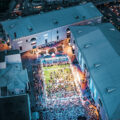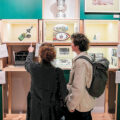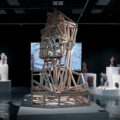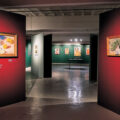- Ансамбль зданий Провиантских складов на Зубовском бульваре. Современный Музей Москвы / Provision Warehouses on Zubovsky Boulevard. The current location of the Museum of Moscow
In its 127 years of existence, the Museum of Moscow changed its name and location many times. Today, it is located in a unique architectural complex, the Provision Warehouses. The museum holds exhibitions, lectures, classes for children, and guided tours, and its courtyard serves as a venue for various festivals and exhibitions.
History
The museum was established in 1896 after the 16th All-Russia Art and Industry Exhibition held in Nizhny Novgorod. The Moscow Pavilion showcased the achievements in the fields of urban development, education, and charity. This exhibition became the basis for the museum, which was organized on the initiative of the Moscow Duma and named the Museum of Moscow Municipal Economy. The collection was housed in the Krestovsky Water Towers.
In 1920, the museum changed its name to the Moscow Municipal Museum. Six years later, its collection was moved to the legendary Sukharev Tower, and after its demolition in 1935, to the Church of St. John the Evangelist under the Elm on Novaya Square. In 1986, the museum was again renamed to the Museum of Moscow History. Finally, in 2008, the museum moved to the Provision Warehouses, a group of buildings in the Empire style located on Zubovsky Boulevard. Along with the new address, the museum received a new name, the Museum of Moscow.
For all these years, the museum has been committed to its mission of studying and preserving the history of Moscow from the first settlements in the region 27 thousand years ago to its becoming one of the world’s largest metropolises. Today, the Museum of Moscow is a cross-disciplinary venue, and its projects cover the entire territory of the city, from Zelenograd to Kapotnya.
Collection
The Museum of Moscow’s collection includes over 850 thousand items. Among them are archaeological artifacts, works of art, documents, photographs and photo negatives, books, furniture, clothing, fabrics, porcelain, and much more. In its storage, one can find one-centimeter-wide coins alongside a 6-meter-long ZIS-110 limousine.
The museum holds the archives of dozens of outstanding Moscow historians and over 300 collections and archives of famous Moscow merchant families: the Bakhrushins, Syreyschikovs, Naydenovs, Vishnyakovs, Shelaputins, Sorokoumovskys. In 2023, more than 21,000 new items were added to the collection.
Moscow Without Limits
One of the museum’s flagship projects is “Moscow Without Limits,” launched in 2021.
The museum’s curators together with local residents, experts, and artists explore various areas of the city. Based on their findings, they put together an exhibition that showcases the features, places of interest, and unconventional tourist attractions of the area. The exhibition culminates the research, but it continues with an educational program carried out at the exhibition and on site and the collection of stories and photographs from the local residents.
By the beginning of 2024, six exhibitions have been held in eight Moscow districts: Tagansky, Kapotnya, Preobrazhensky, Filevsky Park, Fili-Davydkovo, Arbat, Nagatino-Sadovniki, and Nagatinsky Zaton, and a new exhibition dedicated to the district of Ochakovo-Matveevskoye has opened recently.
Exhibitions
Over the past few years, the Museum of Moscow has launched a number of major projects. In 2019, it held its first large-scale exhibition called “The Fabrics of Moscow.” The exhibition covered all stages of textile production development in the city and featured the fabrics produced by local factories, sketches and samples of textiles from different eras, rare photographs, and even machines.
In 2020, the museum held the exhibition “VKHUTEMAS 100. School of Avant-Garde,” which presented this school as the founder of all modern art, design, architectural, and textile universities. In 2021, the exhibition “Electrification. 100th Anniversary of the GOELRO Plan” showed how the electrification of the USSR at the beginning of the 20th century influenced the Soviet avant-garde: fine arts, cinema, architecture, music, theater, literature, and design. Last season, the Museum of Moscow launched the exhibition “House of Models. Image Industry,” which focused on top three “clothing institutes” in the USSR: “Fashion Atelier,” “House of Models on Sretenka,” and “All-Union House of Fashion Models on Kuznetsky Most.”
The Museum of Moscow team’s activity doesn’t stop at that. In April 2024, they are launching the exhibition “Muscovite. Women of the Soviet Capital of the 1920s–1930s,” which will bring together leading museums from all over the country. The exhibition will feature the images of women from the first decades of the 20th century painted by Kazimir Malevich, Alexander Deineka, Alexander Labas, Aristarkh Lentulov, Alexander Tyshler, Konstantin Yuon, and other outstanding artists of the last century. The exhibition will show the women of the 1920s and 1930s who were not only mothers, wives, and professionals but also kept up with fashion trends.
The museum annually organizes lectures, public talks, master classes for adults and children, and the scientific and practical conference “Museum in the City — City in the Museum.” The museum’s various projects provide an opportunity to study the city from different sides through the analysis of its territorial development, stories of local residents, art, and culture.
Anna Podorvanova,
Editor at the Museum of Moscow
Photo: Press Office of the Museum of Moscow




